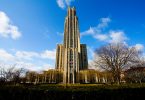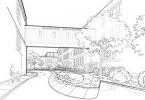SEED Classroom demonstrates healthy, innovative learning space for children
Pittsburgh, Pa. — Phipps Conservatory and Botanical Gardens is pleased to announce that the SEED Classroom has achieved the esteemed Living Building Challenge™ Petal Certification from the International Living Future Institute. Phipps, which achieved Living Building Certification for its Center for Sustainable Landscapes in 2015, is now one of the only campuses in the world to house two International Living Future Institute certified projects, furthering the public garden’s commitment to showcasing one of the greenest built spaces in the world.
In a time when so many learning spaces for children fall short of ensuring the health and safety of their young occupants, the SEED Classroom demonstrates the benefits of creating a modular classroom with environmental and human well-being in mind. School districts often turn to modular buildings when they don’t have enough space in the classroom to house all of their students and can’t afford to expand the conventional brick-and-mortar school building. The SEED Classroom advances a new standard for what these modular expansions can and should look like and calls attention to the importance of providing healthy learning environments for children. Fabricated locally by EcoCraft Homes, Phipps’ SEED Classroom is one of only two of its kind in the U.S.
The SEED Classroom received Petal Certification by achieving five of the Living Building Challenge Standard’s “Petals,” or sets of imperatives for sustainability and wellness in the built environment. These five Petals — Place, Water, Energy, Equity and Beauty — were achieved by carefully documenting the building’s design, construction and performance, demonstrating that the SEED Classroom generates all of its own energy, treats and reuses all water onsite, was built on previously developed land with minimal impact on the environment, includes educational materials that teach guests about how the building functions, and implements other innovative aspects that make it a healthy place for children to learn. This remarkable classroom demonstrates the great benefits humans experience when we take nature into consideration in our built spaces.
The Living Building Challenge certification is the most rigorous standards-based green building certification a project can earn. It builds on what LEED building certification has created to take green building standards to new levels. Living Building Challenge certified projects actually enhance and function as one with their surrounding environments and achieve net-zero energy and net-zero water usage.
THE DETAILS
To reach its net-zero energy and net-zero water goals, the SEED Classroom employs 6 kW photovoltaic solar panels on the roof of the building; a 325-gallon cistern to capture and reuse all rainwater that falls on the roof; a constructed wetland to clean sanitary water; abundant natural daylight; energy recovery ventilators, which create optimum indoor air quality and are the most efficient mechanical systems available; and Structural Insulated Panels, which provide R-49 ceiling and R-40 wall insulation.
To learn more about the CSL, the SEED Classroom and other green projects at Phipps, please visit phipps.conservatory.org.
###
About Phipps: Founded in 1893, Phipps Conservatory and Botanical Gardens in Pittsburgh, Pa. is a green leader among public gardens with a mission to inspire and educate all with the beauty and importance of plants; to advance sustainability and promote human and environmental well-being through action and research; and to celebrate its historic glasshouse. A leader in green building and operations, Phipps has also constructed the first LEED-certified visitor center in a public garden, the first-ever LEED-certified production greenhouses and a tropical forest conservatory that was celebrated as the most energy efficient structure of its kind anywhere in the world when it opened in 2006.
Learn more: phipps.conservatory.org.
About the Center for Sustainable Landscapes: The paradigm of Phipps’ sustainable building efforts, the Center for Sustainable Landscapes was built to be the greenest building in the world, and is the first and only building to meet four of the highest green certifications: the Living Building Challenge, LEED® Platinum, WELL™ Building Platinum Pilot Certification and Four-Stars Sustainable SITES Initiative™ (SITES™). As an integral part of the Phipps visitor experience, the CSL focuses attention on the important intersection between the built and natural environments, demonstrating that human and environmental health are inextricably connected.
Contact: Adam Haas | Interpretive Specialist
412/622-6915, ext. 3803 ǀ ahaas@phipps.conservatory.org






